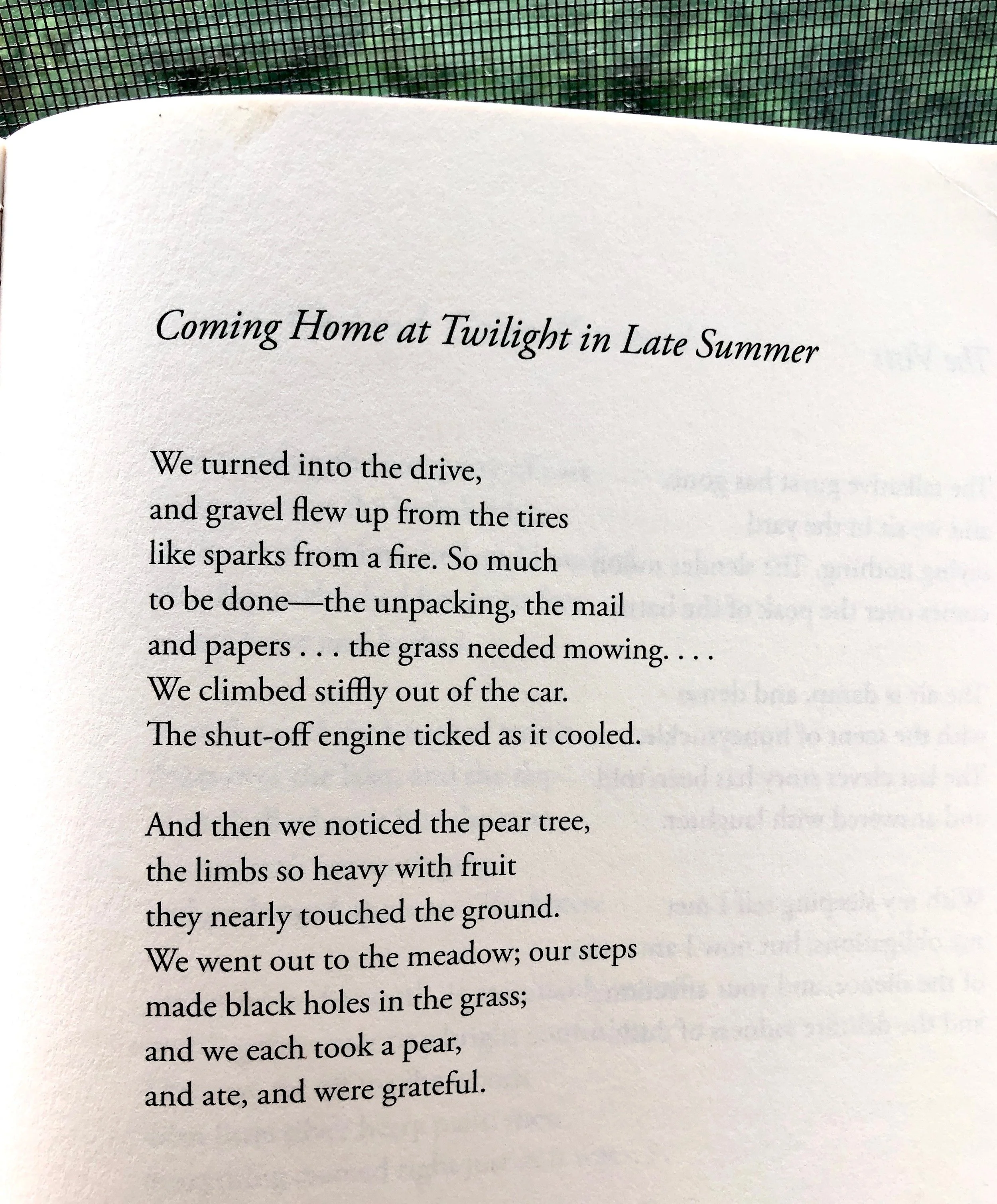Returning to The Scene
I’ve taken two summer trips over the past two weeks. The first was a quick weekend away at the lake with two dear friends, and the second was a trip to Canada with my daughter for her sixteenth birthday. Each time I returned home from traveling, I experienced the ordinary images of my life with a renewed sense of clarity. The prickly weeds erupting in our overgrown yard. My dog’s whiskery muzzle and sandpaper tongue. The warm bristle of my husband’s beard. The familiar scent of home, a blend of plywood and sand and the skin-smells of my family. The usual chaotic piles of papers and books on my desk. The basket of laundry in my closet that I still haven’t put away. It made me think of this Jane Kenyon poem, one of my favorites:
For the past year and a half, I’ve been revising a full-length memoir manuscript. It’s taken longer than I thought and there’s still so much to do. The most humbling part is how little control I have over the process. I can sit down to write every day, but it still takes as long as it takes. The mental and emotional connections necessary for good writing cannot be rushed. I think this is why it takes many memoirists anywhere between five to ten years, if not more, to write and publish their stories. We aren’t making up stories––we are searching for them amid the dark vapor of memory.
I’ve been at the process long enough to know that it takes me about one month to rework a single chapter. I’ve tried to push the pace to two weeks, but I can’t sustain it without burning out. Part of this is the need for downtime, a chance to get away from the page between deep dives. Once I’ve completed an in-depth revision of one chapter, it takes about a week before I can even stand to look at my manuscript again. Just like a neuron, there’s a refractory period between my action potentials.
During this refractory period, I work on other things. Curriculum, individual essays, newsletters, etc. The hardest part is getting started again, knowing that all the work I did on the last chapter is awaiting me with the next one. Each time, I have to break the process into bite-size pieces. Sometimes it’s as simple as this:
Just open the document. That’s all you have to do. Just open it up and look at it.
Sometimes that’s all I can manage. Sometimes when I open the door of my laptop I find a crime scene. Sometimes I find a scene as nostalgic as a high school soundtrack. But it always feels like returning home after I’ve been gone awhile, wondering how I left things, both excited and overwhelmed by what I might find as I pull up the gravel driveway of my word-house.
The first draft of my manuscript was the skeleton and the second draft is the marrow. The first draft was fast and impassioned. The second is slow, granular, brooding, boring, frustrating...but also rewarding in its own way. I’m creating and threading connective tissue between scenes and chapters that were originally bone on bone. With a background in poetry, writing this kind of narration feels unbearably tedious at times, but I know it’s essential, and it’s making me a better writer. It forces me to name connections for the reader that feel obvious in my mind, but the process of naming brings clarity for me, too.
In a recent webinar about second drafts, author Allison K. Williams said that the writers who finish books are the ones who keep going, even after they feel entitled to quit. There are days I feel entitled to quit, days it feels foolish to continue, days I hate it. But whether it’s stubbornness or pride or purpose, something keeps me going. It reminds me of a presentation Bill Glose gave at a writer’s conference last spring. From a large projection screen, the following text stared back at me:
THE FIVE THINGS A WRITER NEEDS TO SUCCEED
The Desire to Write
The Desire to Write
The Desire to Write
Persistence
Willingness to Learn
I often return to this list when I’m exhausted and distraught. How can I continue when I hate my manuscript so much, when the very sight of it yields repulsion? But I suppose that even hatred is a form of desire.
Revision makes me realize how many drafts it takes to get one single scene right. This sobering reality relieves me of the ardent fantasy that anything can be done perfectly on the first go. Just like coming home after a time away, when I return to a scene for the second time, I can see what I didn’t see before, both the mess and the ripened fruit. Though I often dread returning, I now understand the possibility that awaits me behind that door.
All we have to offer is what’s available to us in any given moment, but if we have the desire and willingness to return to the scene again, to wade one step deeper than before, to keep narrowing the gap between past and present, to clarify the patterns hidden within the narrative (the story beneath the story), I find that it changes how I live in the present. Maybe the more we can make meaning from the past (and sculpt it into art!), the more space we have within us to be rooted in the grit and sweetness of the present.
The epigraph of a book I’m currently reading is a quote by Karen Russell: Writing a novel is kind of like scaling Mt. Everest and passing by your own bones on the way. I would say the same feels true of writing a memoir. The byproduct of revising your own story on the page, of extracting art from it, is a kind of desensitization that can set us free. We learn the substance of our bones and then display them outside of us. Our memories and stories are no longer so precious that they dictate our present. The revision process is both misery and freedom, as well as the path to new heights.
searching for sea life along the red, rocky coastline of
Prince Edward Island, Canada
RECOMMENDED READS
I’ve needed a lot of support in the revision process this year, and here are my top-three, recommended craft books addressing the process.
Refuse to Be Done by Matt Bell
I’m reading this right now, and though this book is written for novelists, I find that it applies to anyone writing and rewriting a book-length narrative. Bell breaks the revision process into three simple drafts: the generative revision, the narrative revision, and the polishing revision. I love Bell’s conversational tone, and his ability to break down a convoluted process into concrete, achievable steps.
Seven Drafts by Allison K Williams
This book is a fantastic resource for writing teachers and students. Anyone looking to demystify narrative writing should get their hands on a copy. Williams breaks the process down into smaller components and includes valuable prompts and exercises along the way, helping writers clarify what their story is actually about.
The Art of Revision: The Last Word by Peter Ho Davies
This isn’t so much a how-to book as it is an exploration of the belief systems that guide our writing, one of which is “the myth of the genius for whom it all comes quickly and easily.” Our first drafts are often seen as a product of innocence, delight, and authenticity, while revision is viewed as “a fallen art, a bit grubby when it’s set alongside shining inspiration.” First drafts represent inspiration. Revision requires perspiration. This book is helping me address my false assumptions about the revision process and find the gold beneath the boredom. (I also recommend all the books in The Art Of series…particularly The Art of Time in Memoir: Then, Again by Sven Birkerts and The Art of Recklessness: Poetry as Assertive Force and Contradiction by Dean Young.)
UPCOMING EVENTS & CLASSES
This coming Saturday, July 29th, I’ll be reading from my chapbook, The Heart Room, at Virginia’s Hermitage Museum as part of their “performing ART” series. I’m grateful to be gathering with other artists around Claudio Bueno’s inspiring “Echoes of the Heart” exhibit. If you live in or around Norfolk and would like to come, you can purchase tickets HERE.
On August 4th, I’ll be co-teaching a seminar for the Wounded Warrior Project.
This autumn I’ll be teaching another term of The Memoir Studio, offered online through The Muse Writers Center. Stay tuned for the autumn dates and registration link.
I’ll also be teaching an in-person memoir class this autumn for The Armed Services Arts Partnership, which you can apply for HERE. (Available and FREE for veterans, service members, military spouses/family/caregivers).
PUBLICATION
My personal essay, “Shock Value,” was published in the Vice & Virtue issue of The Other Journal. It’s one of the most vulnerable essays I’ve published and examines how my own sexual history connects to my desire for/fear of true intimacy. You can read it online HERE.
WRITING PROMPT
Return to a scene you’ve written about and then abandoned in a drawer, a journal, or a computer file. Dust it off and read it again with fresh eyes. Try revising with the following questions in mind: How can you enter deeper into the scene this time, with all of its specific sensory images? Where are you in time and place? How can you bring the language closer to your body? How did/do you feel about this experience? Who is narrating the story––your past or present self? How does this scene connect to others in your life? How did this experience impact who you are today? Don’t worry about getting in perfect…just one step closer to complete.
sunset over the Gulf of St. Lawrence




